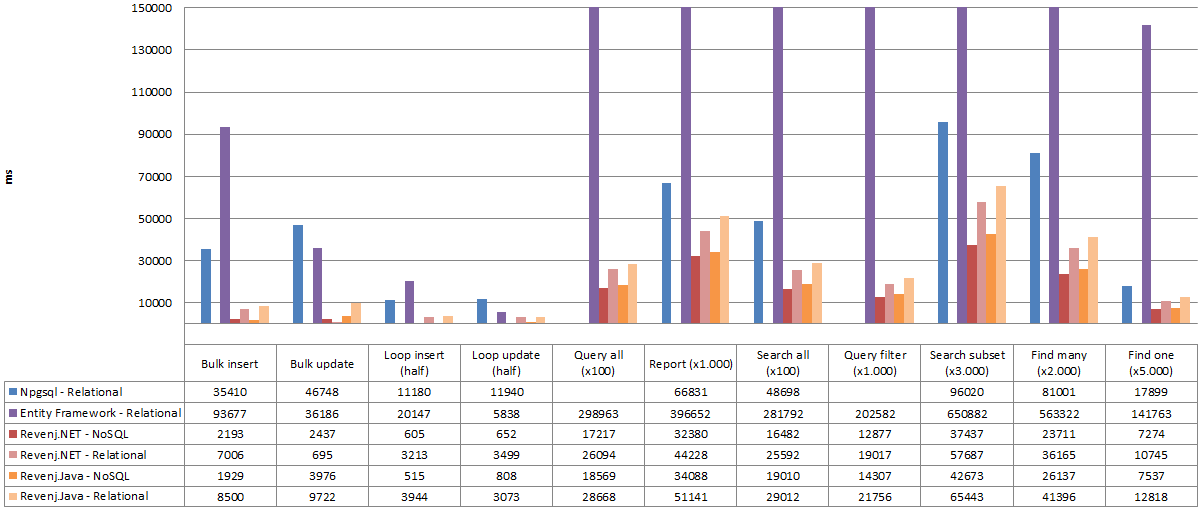##Database access layer benchmark
This is reference benchmark for Revenj framework data layer.
Varieties of models are tested, from small simple objects, to very complex large objects.
Don't consider this a database benchmark, since there is no network roundtrip and only single client thread is used to talk with the database.
###Models
###Testing assumptions
- loading of whole aggregate
- simple model is a single table data source
- standard model represents a parent/child relationship. Implementation is free to choose a single table or two tables
- complex model represents a parent/child/detail relationship. Implementation is free to choose a single table or three tables
- multiple test types:
- batch insert/update (single transaction)
- insert/update in a loop (multiple transactions)
- primary key lookups
- optimized search (known in advance)
- LINQ search (runtime conversion)
- report (loading of several data sources)
###Libraries
- Npgsql (2.2.4.3) - used to implement manual SQL approach; talks to Postgres using binary protocol (never version exists, but it's mostly slower and require some code changes... will be added later)
- Revenj (1.2.1) - implemented both as a "standard" relational approach with aggregation in a single object and as a "NoSQL" object oriented approach; Uses customized old Npgsql which talks to Postgres using text protocol
- Entity Framework 6 - most popular .NET ORM.
- Hibernate 5 - most popular Java ORM.
- JDBC PostgreSQL (9.4-1202) - official JDBC driver for PostgreSQL
- MsSql ADO.NET - not included in results, but you can run the bench to see how it stands
- Oracle ODP.NET - not included in results, but you can run the bench to see how it stands
###Single table test
Small table which should reflect simple database interaction. Npgsql does not implement "true" batch inserts/updates, but rather reuses the same command.
Interestingly Postgres can return few columns using binary protocol up to 3x faster than a record using text protocol.
###Parent/child test
Standard pattern which is implemented as two tables in a relational database, but can be implemented as a single table in an object-relational database. Npgsql can't really be used for "NoSQL" approach since it would require a lot of complex code.
###Parent/child/child test
Sometimes complex nested tables are required. Due to multiple roundtrips, unoptimized bulk insert/update performs really poorly. Manual SQL code is starting to be really complex.
###Reproducing results
Run GatherResults.exe by pointing it to an Postgres instance
Individual tests can be run as:
- DalBenchmark.exe (example: DALBenchmark.exe Npgsql Simple 10000)
If you are interested in changing the models, then you can:
- install Visual studio plugin: DDD for DSL
- or use dsl-clc
###Results:
Full results are available in Excel spreadsheet.
Bench was run on Windows7 with Postgres 9.3 locally installed.
###Conclusions:
- Manual coding of SQL and object materialization is often not the fastest way to talk to the database
- Complex models will benefit from "NoSQL" approach to modeling
- DSL Platform compiler will create a lot of boilerplate in the database, but it will also put that boilerplate to use
- Postgres JDBC driver performance has improved significantly with version 1202


